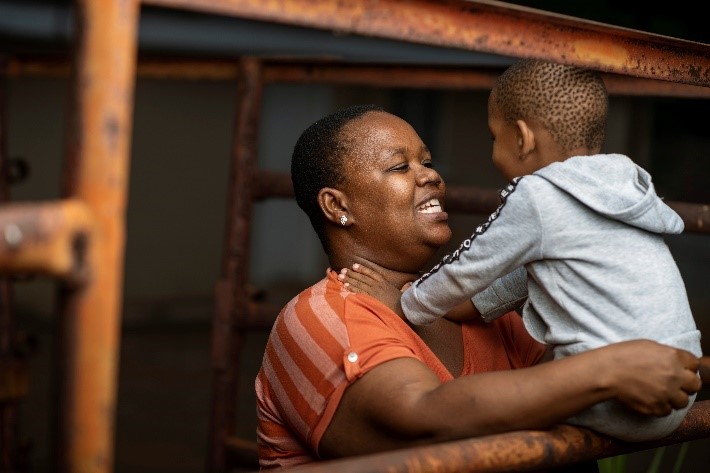Botswana’s programme for elimination of mother-to-child transmission (EMTCT) of HIV builds on Botswana’s strong foundations of public health and primary health care, a commitment to quality sexual and reproductive health (SRH) services, and 20 years of a strong national response to one of the highest HIV epidemics in the world. With an HIV prevalence among pregnant women estimated as high as 37% in 2003 [1] and now approximately 20%, Botswana initiated its prevention of mother-to-child transmission program in 1999, rapidly achieved national coverage and successively implemented more effective treatment regimens based on WHO guidance. With programme implementation at scale, the first elimination impact indicator, the estimated mother-to-child transmission rate reduced to 1.9% in 2019, below the less than 5% needed for EMTCT. High HIV prevalence, however, made it impossible in 2019 to reach the second elimination impact indicator of <50 incident pediatric cases per 100 000 live births. As such, Botswana is now on the “path to elimination”.
WHO’s work in Botswana is based on a strong Country Cooperation Strategy (2014 – 2020), of which two strategic priorities respond to the need to reduce the country’s high burden of HIV (Strategic priority 1) and reduce morbidity and mortality and promote health through the life-course (Strategic priority 3). The work of the WHO Country Office, supported by regional and headquarters levels, focused on the following areas: (1) Strengthen HIV/AIDS response through the provision of normative guidance on legislative, policy and implementation of quality services, surveillance, monitoring and evaluation; (2) Improved maternal, newborn, child, and adolescent reproductive health while promoting active and healthy lives through evidence-based policies, guidelines and strategies; (3) Strengthened capacity for programme planning, organization, implementation of quality reproductive, maternal, neonatal, child and adolescent health (RMNCAH) interventions; (4) Strengthened health promotion, disease prevention, universal health coverage, and entrench Health in All policies; and (5) Strengthened policies strategies and, guidelines to address environmental risks to health and climate change, including improved information systems and mapping.
With strong commitment and openness from the Botswana Ministry of Health and Wellness, the Botswana National Validation Committee led a validation assessment of the EMTCT programme and its beneficiaries and developed a national report describing the results. The assessment was supported by WHO in collaboration with the Joint United Nations Programme on HIV/AIDS (UNAIDS), the United Nations Children's Fund (UNICEF) and additional partners, including the United States Centers for Disease Control and Prevention. The national report was reviewed by the WHO-led Regional Validation Secretariat and team that included independent experts and representatives of women living with HIV. In-depth review and validation of national programme data and spectrum-modeled estimates determined that Botswana had met the required elimination impact and process indicators to be on the silver tier for HIV path to elimination. As the sixteenth country to have undergone the review and validation process, Botswana became the first African and first high-burden country to have been validated for EMTCT of HIV in October 2021.
Success of Botswana’s HIV EMTCT program is attributed to factors including: strong national leadership and commitment to EMTCT, with political commitment exemplified by regular presentations of the EMTCT situation in Parliament; policies, guidelines and strategic plans consistent with WHO recommendations; a well-implemented EMTCT service delivery model integrated within both SRH/ Reproductive maternal, newborn, child and adolescent health (RMNCAH) and HIV services at all levels; data collection systems that provide aggregate monthly data, more detailed data increasingly being collected; a laboratory system that participates in regular external quality assurance and proficiency testing, algorithms and testing done according to international standards; domestic financing of both national and public health systems including free HIV services; and inclusion of strong policies to promote respect for human rights, informed consent, confidentiality, gender equality, and community engagement.
While recognizing these strong accomplishments, areas for improvement were noted and recommendations made which will support Botswana to reach near or full EMTCT. WHO is supporting the country to address recommendations, strengthen and update (i) programme management, policies and implementation strategies, (ii) the national data monitoring and analysis system, (iii) laboratory testing and quality assurance, and (iv) human rights protections including increasing meaningful engagement of women living with HIV at all levels. Botswana is strongly encouraged by WHO and partners to continue its commitment to strengthen its syphilis programme and begin planning for EMTCT of Hepatitis B virus, in anticipation of applying for “triple elimination” of mother-to-child transmission of HIV, syphilis and hepatitis validation using guidance released by WHO in 2021.

Photo Credit: © WHO Country Office in Botswana
Photo Caption: Dora, 37-year-old mother living with HIV, playing with her 3-year-old son at their house in Serowe, November 2021.
REFERENCES
[1] Botswana National AIDS Coordinating Agency (NACA). 2003 Second Generation HIV/AIDS Surveillance Technical Report. Gaborone, Botswana: NACA; 2003.
[2] Regional validation report on Botswana’s path to elimination of mother-to-child transmission of HIV. WHO Regional Office for Africa, 202
Photo Credit: © WHO County Office in Botswana

